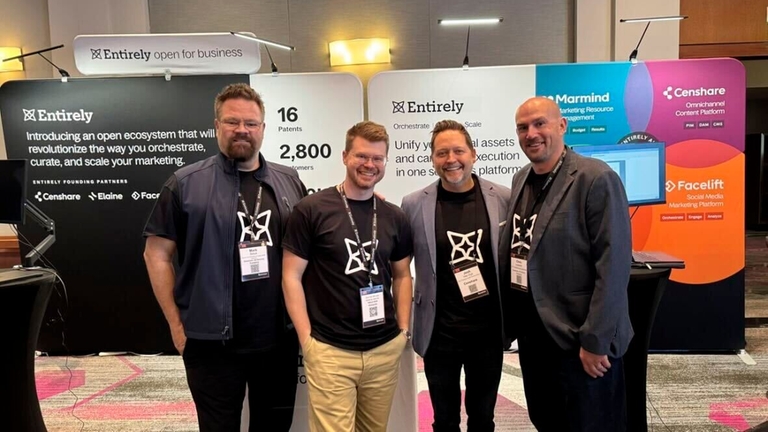Plus, how to do it without disrupting business.
Most B2B companies don't replace their Product Information Management (PIM) and Enterprise Resource Planning (ERP) systems simultaneously. The risk is too high, the coordination too complex, and the potential for disruption too great. But ESA, a Swiss automotive cooperative serving 7,000 B2B customers, did exactly that—it replaced its PIM and ERP while managing 500,000 product data assets without a single service interruption.
For ESA, this was a well-calculated decision based on a few warning signs that they saw and addressed.
If you’re experiencing even three of these five warning signs, it may be that you’re facing a similar inflection point. Fortunately, replacing such essential systems like PIM and ERP at the same time can be done, but delaying the process could be costly.
Warning sign 1: Teams are struggling with manual data transfer
This looks like: Marketing creates product information in one system, then manually copies it into another. Sales teams maintain separate spreadsheets because they can't trust the data in your CRM. Each product update requires changes in five or more different places. "Data entry"—of any kind—consumes 20-30% of knowledge workers' time.
If it’s not truly broken, why fix it? The reason these are warning signs is that manual data transfer processes introduce errors; information becomes outdated quickly, so the copy/paste data process is inefficient both from an immediate workflow perspective and from a long term efficiency perspective; and your team’s expertise ends up being wasted on repetitive tasks, rather than on strategic work.
When error rates start impacting customer experience or when you're hiring people primarily to move data between systems, you've crossed from "inefficient" to "unsustainable."
Warning sign 2: It’s difficult to answer basic questions about your product information
This looks like: Identifying which products are in which markets/channels is difficult or time-consuming. The question, “how many products do we have?”—yields different answers, depending on who you ask. It may be that finding the “latest version” of product specifications requires detective work. It may also be that marketing doesn’t know whether the product data they are using for campaigns is current.
These are problems because they have to do with your product. Inaccurate product information directly impacts revenue, whether it’s the wrong price, an outdated spec, or a missing item. Meanwhile, compliance and regulatory risks multiply if/when you cannot verify which information is published where. And if strategic decisions to discontinue products or expand to new markets are based on incomplete data, executives may stop trusting reports from your systems or request manual audits.
If a compliance issue has been traced back to conflicting product data, you’re at a tipping point.
Warning sign 3: Channel expansion becomes prohibitively complex
This looks like launching a new shop, but it requires 6+ months of data preparation. Or: each new sales channel needs custom integration work. If your print catalogs and digital channels show different product information, channel expansion is getting too complicated. Or, if you are manually creating separate product feeds for each marketplace or platform, that’s also a warning sign.
What this tends to mean is that market opportunities pass while you're still "getting the data ready.” Brand trust may be eroded because of inconsistent information across channels, and technical constraints, not market demand, limit revenue potential.
If you have turned down revenue opportunities because you "can't support another channel right now," or if maintaining existing channels consumes all available IT resources, it may be time to consider replacing and integrating your systems.
Warning sign 4: Formerly “temporary” workarounds are now just how it’s done
This looks like:
- Critical business processes depend on Excel macros created by someone who left the company
- You have middleware or custom scripts connecting systems that "we'll replace eventually"
- Team members have built personal databases because official systems don't meet their needs
- Onboarding new employees requires training on 8+ different tools plus undocumented workarounds
These aren’t small problems: Workarounds create technical debt that compounds over time. As dependencies multiply, your infrastructure will become increasingly fragile. And if only two or three people understand how things actually work, that’s a risk: knowledge shouldn’t be so concentrated.
Tipping points: When a key person leaving would genuinely threaten business operations, or when you're spending more time maintaining workarounds than the original problem would have cost to fix properly.
Warning sign 5: It feels too risky to attempt a system replacement
This looks like: Modernization discussions get tripped up by the sense that you and your teams can’t afford any downtime. You’ve talked about replacing your PIM/ERP for three or more years, but reasons to delay keep the conversation from moving forward. If asked, your IT team would admit it’s in permanent firefighting mode to keep legacy systems running. And it may be that you are paying increasing maintenance costs for systems nearing end-of-life.
The problem here is that risk doesn’t decrease with more time; it tends to increase as systems become more outdated and brittle. What makes this more problematic is that competitors may be modernizing while you maintain. And eventually, you may even face a forced migration on someone else’s timeline, whether because of vendor discontinuation or security vulnerabilities.
This is the paradox: when replacement feels most risky is often when it's most necessary. If your answer to "what happens if this system goes down tomorrow?" is genuinely frightening, you're past the warning sign.
Case Study: How ESA Replaced PIM and ERP Without Disruption
ESA, the leading cooperative purchasing organization for the Swiss automotive industry, supports more than 7,000 co-owners with a catalog exceeding 500,000 products. To stay competitive, ESA undertook one of its most ambitious modernization initiatives: replacing its outdated ERP and Product Information Management (PIM) systems simultaneously, while unifying Digital Asset Management (DAM), PIM, and Content Management (CMS) into a single connected platform.
This holistic transformation established a single source of truth for all product, media, and marketing data, eliminating silos between departments and streamlining processes across IT, product management, sales, and marketing.
Why they chose dual replacement:
ESA’s existing systems had reached their limits. The ERP system, which served as the central data supplier, needed to be modernized to support integration and automation. Meanwhile, the legacy PIM system could no longer manage or distribute the thousands of product data assets that powered ESA’s online and offline channels. Data handling had become too complex, and teams were working across disconnected tools for content creation, media production, and approval workflows.
How they did it without disruption:
To achieve dual-system replacement without service interruption, ESA adopted a strategy of integration-first design and close vendor collaboration. Censhare provided the unified data and content hub, while the new ERP served as the central supplier of product, pricing, and stock information. This ensured synchronization between systems and allowed ESA to maintain continuous operations for all 7,000 B2B customers.
The results were both operational and strategic:
- Zero service interruptions during the migration
- 500,000+ products managed in a unified platform
- 5+ online shops and 80 annual flyers now automatically updated from one source
- Faster, more accurate data distribution across all channels
Internally, ESA’s teams now benefit from better coordination, shared data visibility, and a connected foundation that supports future growth and omnichannel publishing.
The cost of waiting vs. the risk of acting
When it comes to modernization, the real question should be: “Can we afford the inefficiencies and opportunity costs of doing nothing?” It might be worth actually quantifying what delay costs you. Consider assessing:
- Time lost to manual data transfer and maintenance workarounds
- Missed revenue from channels you can’t yet support
- Customer experience or compliance issues tied to poor data quality
- Rising maintenance costs for systems approaching end-of-life
ESA’s success shows that modernization doesn’t have to mean disruption. With clear planning, cross-functional coordination, and the right technology foundation, even the most complex integrations can strengthen business continuity, rather than endangering it.
Censhare helps companies with massive system replacements like ESA’s. Let’s talk about what first steps could look like for your company:
Talk to a Censhare expert







